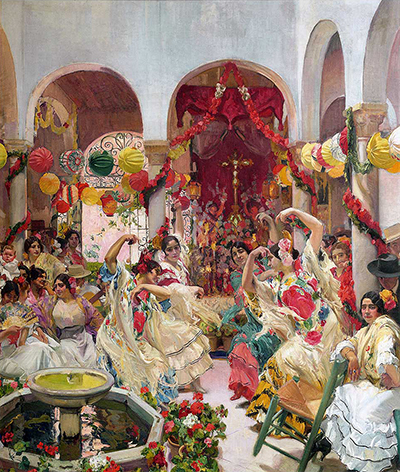Seville, the Dance was a painting from 1915 which formed part of a larger series of works known collectively as Vision of Spain. There were fourteen in total, all completed by Joaquin Sorolla over a period of six years.
One can compare this series to Alphonse Mucha's Slav Epic, though the Czech's project featured different historical events from the past 1500 years. In the case of Sorolla's Vision of Spain, the artist decided to actually capture fourteen different regions of the Iberian Peninsula, without necessarily any specific connection to historical events. Seville, therefore, was represented by the beautiful artwork which lies in front of us here, though he also produced Sevilla, The Bullfighters in the same year of 1915 plus Sevilla, Holy Week Penitents in the year before. Sorolla was immensely proud of the rich culture and beautiful landscape of his nation and was delighted to work on this series of large scale paintings which helped to promote the region's values to a wider audience. With a century having passed since these canvases were finished, we can now use them as a historical tool is learning more about the cultures of specific Spanish regions thanks to the precision of detail that he incorporated into each one.
The painting in front of us here, known as Seville, the Dance, offers a view into the vibrant culture of Spain. We find here a festival atmosphere, with decorative elements hanging from the walls around this small courtyard. Classical arches are adorned with bright colour as the residents below celebrate with dance. The scene is filled entirely with women, dressed in multi-layered traditional clothing and flowers in their hair. A few smartly dressed men in suits can be seen to the right hand side but this appears to be a moment for the women to enjoy this festival, a chance to dress up and dance to local music which no doubt would have been playing at the time. In the foreground is a pretty fountain that gives Sorolla the opportunity to reflect light around the painting as well as adding extra architectural interest to this intriguing piece. It truly is a delightful piece that sometimes gets lost within the overall series of the Vision of Spain, but we consider it to be one of Sorolla's best paintings.
The overall series spanned 1913-1919 although Sorolla did work on other projects during that time. It was commissioned for the Hispanic Society of America in New York City, and remains on display there today, with a recent refurbishment of the room coming about in 2010. The paintings are themselves up to 14 feet in height and so must be catered for in a unique manner by any art gallery, such is the unique size of these pieces. It is rare for the Hispanic Society of America, New York City to loan them out, but they did so during the refurbishment which gave the Spanish a rare opportunity to see these items in person, as they toured around Spain for an extended period. Today they are back in place in New York City, helping locals to reconnect with their Spanish roots via these huge canvases which cover a variety of different parts of the Iberian Peninsula and celebrate its qualities to the full. Their value today, collectively is huge, both in terms of potential monetary value, but also their relevance to the expat communities living within the US.




 Sevilla, The Dance Joaquin Sorolla.jpg)
